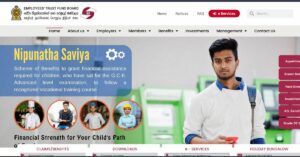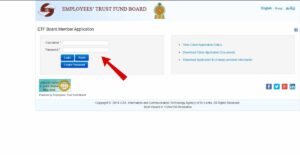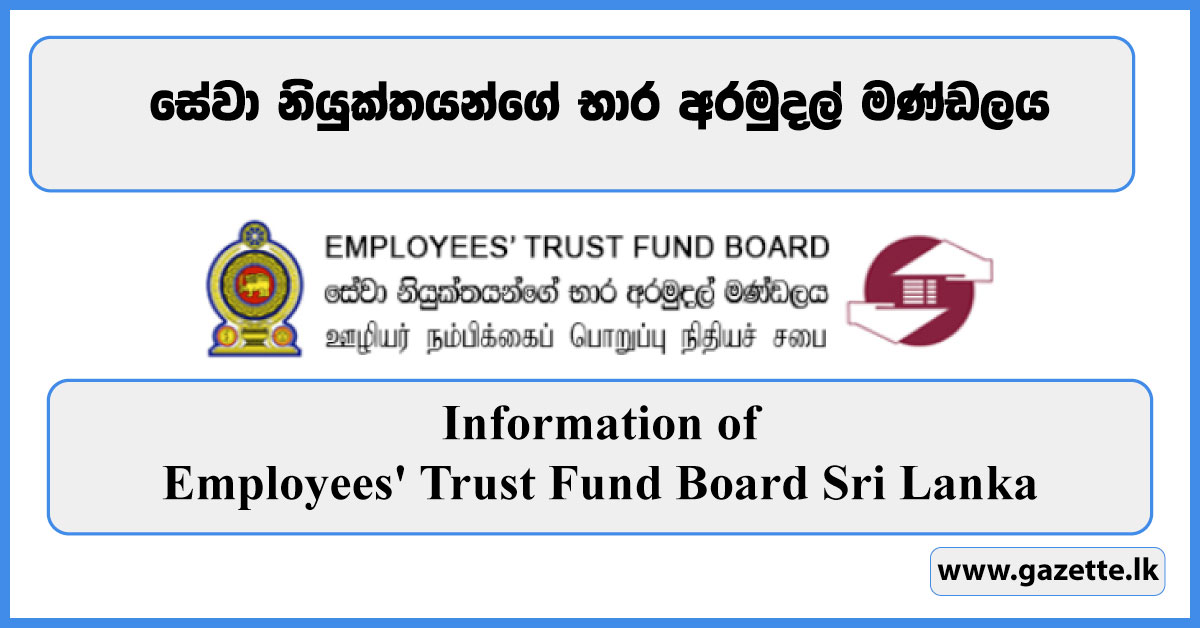Thus, the Employee Trust Fund (ETF) plays an important role acting as a source of fund to secure employees’ future in Sri Lanka. In this regard, it is good for you whether you are an employer, employee or a retiree to know how to make claim for your ETF benefits. Read below to get a detailed description of the claim process of the ETF as well as all available benefits and contributions, which is described in this tutorial. You can be sure that you are maximizing the use of the ETF system with enhancing your information and using the internet.
ETF Board Sri Lanka Contact Details
| Address | 151 Bernard Soysa Mawatha, Colombo 00500 |
| Telephone | +94 11 7747200 +94 11 7747800 |
| Fax | +94 11 2503917 |
| chairman@etfb.lk | |
| Website | etfb.lk |
| E-Service Website | e-Services |
| facebook.com/Employees-Trust-Fund-Board | |
| Youtube | youtube.com |
Who initially introduced this ETF system
Under guidance of President J.R. Jayewardene, the government of Sri Lanka created the Employee Trust Fund (ETF) system in 1981. The Employee Trust Fund Act No. 46 of 1980 established it. The ETF’s goal is to provide a consistent savings plan for workers through providing social welfare benefits and financial security to employees in the private and semi-government sectors. The program was a part of larger economic changes meant to improve worker welfare and provide Sri Lankan employees advantages over time.
How to Claim ETF in Sri Lanka
If you follow the right processes and submit the required paperwork, claiming the Employee Trust Fund (ETF) in Sri Lanka is a simple process. Here is a thorough how-to:
01. Check Eligibility
In the event of the following, you can claim your ETF:
- Retirement: 55 years old for men and 50 years old for women.
- Termination or Resignation: If you resign your job and don’t return to it.
- Permanent Disability: In the event that a persistent disabilities prevents the ability to work in the future.
- Death: Either beneficiaries or true heirs may file a claim in the event of death.
02. Gather Required Documents
To claim ETF, you will need the following:
- ETF Application Form (Form “L”): This form can be obtained from the ETF Board or downloaded from the ETF website.
- To Download the Form : Click Here
- National Identity Card (NIC): A certified copy of your NIC or passport.
- Employer’s Certification: A letter from your employer confirming your employment details and period of service.
- Bank Account Details: A certified copy of your bank passbook or a letter from the bank to facilitate the transfer of funds.
- Medical Reports: In cases of permanent disability, you need medical certification.
- Death Certificate: For beneficiaries claiming the ETF in the event of death.
03. Submit the Application
Send your completed claim form and any other paperwork to the ETF Board via registered mail or in person. To avoid delays, make sure the paperwork are properly completed and certified.
04. Processing Time
Depending on the completeness of the application and additional checks, the ETF Board often needs 4 to 6 weeks to process and approve the claim.
05. Receive Payment
The ETF amount will be directly deposited to the bank account you specified throughout the application process if your claim is accepted.
06. Track Your Claim Status
By using the ETF Board website or getting in touch with the ETF office directly, you can keep track on the progress of your ETF claim. Additionally, you can use your NIC number to check your ETF balance online.
To Visit ETF Board Official Website: Click Here
You may successfully claim your ETF and guarantee an easy processing experience by following these steps.
| Benefit Type | Description | Purpose/Advantage |
|---|---|---|
| Retirement Benefit | Provides employees with their ETF savings upon retirement, offering financial support for their post-service years. | Ensures financial stability for retirees. |
| Permanent Disability Benefit | Allows employees to access their entire ETF savings if permanently disabled and unable to work. | Reduces financial pressure caused by the inability to earn an income. |
| Death Benefit | Nominees or legal heirs receive the employee’s accumulated ETF balance in case of the employee’s death. | Provides financial relief to the employee’s family during difficult times. |
| Housing Loan Facility | Offers financial assistance for housing needs, enabling members to secure or improve their living conditions. | Supports homeownership or housing upgrades. |
| Medical Benefits | Provides financial aid for surgeries, hospitalization, and critical illnesses. | Reduces the financial burden of unforeseen medical expenses. |
| Educational Assistance | Offers monetary support for children’s school needs, such as books and supplies. | Enhances the educational opportunities for employees’ families. |
| Maternity Benefit | Provides financial assistance to female employees for maternity-related expenses. | Covers costs associated with pregnancy and childbirth. |
| Reimbursement for Professional Development | Offers financial support for professional courses to enhance skills and qualifications. | Helps employees advance in their careers and remain competitive in the job market. |
| Scholarship Program | Provides scholarships for employees’ children who excel in national examinations like GCE O/L and A/L. | Supports high-achieving students in pursuing further education. |
This table highlights the various benefits provided by the ETF, demonstrating its contribution to employee welfare beyond retirement savings.
ETF Contribution Process in Sri Lanka
Sri Lanka’s ETF is a compulsory that employers in the private sector and some semi-government organizations need to get involved with. Ensuring that the staff have a stable source of income after they have retired, companies make regular contribution to the aforesaid organization. This is how the process works:
01. Employer’s Responsibility
Employees of all private and semi-government employers are required to register with the ETF.
The sole individual responsible for investing to an ETF is the employer; none of the funding is withdrawn out of the worker’s pay.
02. Contribution Rate
Each month, the company pays a 3% investment to the employee’s ETF out of their whole earnings, which include their basic salary, bonuses, and allowances.
Based on the employee’s gross payment, this amount is calculated.
03. Payment Schedule
ETF payments must be made by employers on a monthly basis. Each month’s donation must be sent in by the last day of work of the following month, at the latest.
Penalties or surcharges may be applied for late payments.
04. Method of Payment
Employers can use the ETF e-Services portal or approved banks to pay ETF contributions. Employers can ensure efficiency and convenience by allowing online payments.
Contributions must be supported by the required paperwork, such as salary breakdowns and employee details.
05. Contribution Reporting
Together with the payment, employers are required to send a monthly report that includes the employee’s name, NIC number, monthly salary, and amount contributed.
This guarantees that each employee’s contributions are properly recorded.
06. Employer Registration
When hiring their first worker, employers are required to register with the ETF Board by submitting relevant company paperwork in addition to an application form (Form ‘B’).
An exclusive ETF reference number is given to the employer upon registration; this number is used for all future contributions and transactions.
07. Employee’s ETF Account
Following contributions, a unique ETF account number is given to every employee. Using the ETF Board’s online portal, employees can use their NIC number to check the balance of their ETFs.
Over time, contributions build up in this account, giving employees long-term savings.
08. Penalties for Non-compliance
Businesses who failed to register employees, pay on time, or provide precise information may suffer fines, legal legal action, or additional penalties from the ETF Board.
Employers protect their employees’ future financial security by following the ETF contribution method. The fund supports retirement, healthcare, and other benefits and is a vital part of Sri Lankan employee welfare.
How to Check ETF Balance Online in Sri Lanka
To check your Employees’ Trust Fund (ETF) balance online in Sri Lanka, you have two main options:
Option 1: Check ETF Balance Online
- Go to Employees’ Trust Fund Board Offical Website. etfb.lk


- Create a Member Login Account
If you don’t already have an account, you can request one through:
- Your Employer: They can submit a request to the ETF Board to create login accounts for their employees
- Direct Request: Submit a completed “Application for Member Request for ETF e-Services” to the Member Accounts Division at the ETF Head Office or the nearest regional office.
- Log In to the ETF Portal
Once your account is set up, visit the ETF Member Login page and enter your credentials. - View Your Balance
After logging in, you can view your current ETF balance and update your contact information.
Option 2: Check ETF Balance via SMS
You can also check your ETF balance using your mobile phon:
- Send an SMS
Using the mobile number registered with your ETF account, send the following message:ETF BLC [YourLoginUsername]
Send this SMS to 1919.
- Receive Your Balance
You’ll receive a reply SMS with your current ETF balance.
Need Assistance
If you’re unsure about your login details or need further assistance, you cnn
- Visit a Regional Office: The ETF Board has 19 regional offices across Sri Lanka where you can inquire about your account.
- Contact the ETF Board:
- Phone: +94-11-7747200 or +94-11-250317
- Email: info@etfb.lk
Feel free to ask if you need help with any specific step!
FAQ about ETF
01.What is the ETF?
In Sri Lanka, for the private and the semi-government employees, government grants the Employee Trust Fund (ETF). Employers contribute to the fund that offers for instance disability assistance and retirement through a subscription charged at 3% of the workers monthly wages.
2. Who is eligible for ETF contributions?
ETFs are allowed to be contributed by all private sector employees and also employees in certain specified semi government organizations. The benefits should be offered by the employer and not the employee.
3. How much is contributed to the ETF?
Employers contribute 3% of an employee’s gross monthly salary towards the ETF. This include any other income excluding the base wage for an employee, including bonuses and allowances.
4. Can I make personal contributions to my ETF account?
Therefore, contributions to the ETF are only required from employers. Employers are not allowed to accept personal contributions for its employees.
5. What documents are required to withdraw my ETF?
- Two, ETF Withdrawal Form (Form “L”).
- NIC or Passport copy
- Letter from the employer
- Bank account details
- Other papers as the reasons for withdrawal may be depending on the reason for, for example, medical or death certificates.
6. How many minutes does it take to process an ETF claim?
4 to 6 weeks
7. Is it easier to do a quick check and see what is the balance on etf?
ETF Board’s website The following FAQs explain significant features of the ETF system in Sri Lanka and are useful for the current and potential employees to know about their rights and entitlements.
Conclusion
In Sri Lanka there is a compulsory savings scheme called the Employee Trust Fund (ETF) operated by the government exclusively for employees in the private and semi-government sectors that was meant to be protection and source a of financial assistance. It is mandatory by law that part of a worker’s salary should be contributed to the fund by his employer, which can be accessed by the employee on leaving the company or by them at times like retirement, resignation or even disability.
This way the ETF tries to enhance the quality of the lives of employees in Sri Lanka having the opportunity to cover their medical requirements as well as education and many others. Both employers and employees need to understand ETF system to ensure right investments to be made and timely payments to be made for the same.


